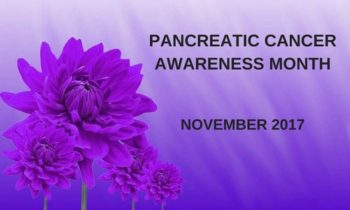 4 RISKS AND 4 SYMPTOMS
4 RISKS AND 4 SYMPTOMS
Welcome everyone to another FACTUAL FRIDAY. It’s November — and in addition to the upcoming Holidays for which November is known – it’s also PANCREATIC CANCER AWARENESS MONTH. So, this blog is devoted to this somewhat elusive cancer that affects over 60,000 people each year in the United States alone.
Now, pancreatic cancer is what I call a “silent cancer” in that it often remains asymptomatic and undiagnosed until it is more advanced. And this, of course, is troublesome because early detection is vital in treating any cancer successfully. This cancer also is the tenth most common among both sexes but strikes men more often than women.
Yet, we can give ourselves a huge heads-up if we know the risks for this cancer and understand the subtle symptoms that may indicate its presence.
So, let’s get started by reviewing the 4 MAJOR RISK FACTORS for Pancreatic Cancer:
- TOBACCO USE. It doesn’t matter if tobacco is smoked, sniffed or chewed, the carcinogens in the product have been linked to the development of almost every cancer, including that of the pancreas.
- OBESITY. A diet high in fatty foods not only adds unnecessary weight, but it forces the endocrine system to work harder in order to digest the increased amount of carbohydrates and fat. This may weaken the pancreas and leave it vulnerable to several diseases, including pancreatic cancer.
- OCCUPATION. Individuals who work with petroleum and chemicals found in leather tanning, laboratories, auto mechanics and photographic manufacturing share an increased risk for developing this cancer.
- MEDICAL HISTORY. As with many cancers, heredity is so important in assessing our risk for this cancer. If your family history includes Lynch syndrome, von Hippel-Lindau syndrome, Peutz-Jeghers syndrome, cirrhosis of the liver, diabetes mellitus, hereditary breast and ovarian cancer syndrome, familial atypical multiple mole melanoma syndrome (FAMMM) or hereditary nonpolyposis colon cancer (HNPCC) your risk for pancreatic cancer may increase.
And now, let’s move on to 4 SUBTLE SYMPTOMS that may indicate the presence of Pancreatic Cancer:
- PAIN IN THE ABDOMEN OR BACK. Physical exercise and exertion can explain this type of specific pain. But, if pain in these areas continues without explanation it could be indicative of a more serious problem, including pancreatic cancer.
- NONSPECIFIC WEIGHT LOSS. Most of us gain or lose a few pounds over a given year. But, if we experience a rather sudden and unexplained weight loss of twenty pounds or more, a number of different cancers, including that of the pancreas, might be indicated.
- JAUNDICE. This term comes from the French word for yellow, which is jaune. Also known as icterus, this yellowish pigmentation of the skin and whites of the eyes may indicate that body toxins are not being properly eliminated by the endocrine system. Accordingly, this could indicate a serious condition of the pancreas such as cancer.
- DARK URINE. Now, many things can change the color of our urine like medications and certain foods. The color also can change if there is a harmless and temporary presence of blood in the urine. But, if this discoloration continues without explanation it can be related to a more serious condition, including pancreatic cancer.
Unfortunately, we can’t stop cancer completely. But, we can learn all about the disease and arm ourselves with knowledge and information. And with these important tools we can Take Charge of our personal healthcare and become Pro-Active Advocates for wellbeing!
This is a cancer that has affected my family and me personally. So, in honor of PANCREATIC CANCER AWARENESS MONTH, please take a little time to research your family medical history and reflect on your lifestyle. Then take the necessary steps to modify and reduce your personal risk for this particular cancer. And, always pay attention to the warning signs.
Once again, thanks for joining me everyone. Until next time, stay in GOOD HEALTH and . . .
TAKE THE COURSE AND TAKE CHARGE!



Leave a Comment